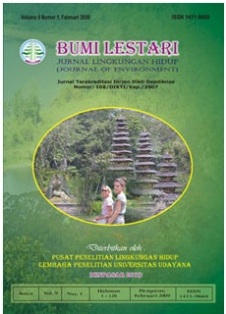PERUBAHAN FUNGSI LAHAN DI MUARA SUNGAI TERHADAP PELESTARIAN SUMBER DAYA AIR
Abstract
Bali has many rivers with river water discharge conditions is quite large and a lot of wasted at the mouth of the river in vain , because not all of the water used for agricultural needs and raw water . Current physical land in the mouth of the river has begun to change from agricultural land into building that support tourism in Bali This is in line with the development of tourism industry of small -scale tourism and large -scale tourism . In line with this condition, the problem is how the characteristics of the river mouth in Bali with the change in land use in the mouth of the river and how water resources management methods that go into the mouth of the river so that water resources be sustainably. Researchmethods that will be used is phenomenology . This is in accordance with the principle of preservation of objects that many studies related to water resources management system . The research process consists of two stages . Results obtained in the form of characteristics of the river , the river mouth morphology after land use change around the mouth of the river, based on secondary data ( reports of Bali Provincial Department of Public Works ) and
research in the field ( primary data ) , this study uses the software as a tool of analysis . Karakteristik morphology Sowan estuaries ( Perancak and vicinity ) is influenced by the tide . The slope of the river estuary is very gentle with the deposition of sediments in the estuary level is relatively high .Research materials are mostly primary data are searched directly in the research area and equipped with relevant secondary data from the last 5 years of data. Sowan river basin area 205,818 km2 , with rainfall in the basin is about 1,900 mm per year . Kondition for environmental water quality in the river mouth area Sowan obtained Perancak beach water quality data obtained magnitude BOD levels 10.61 mg / l
and COD levels of 16.47 mg / l . Watershed wide Badung of 52,497 km2, land conditions in the estuary area of Badung in Denpasar . Land use changes that often occur lately triggered sedimentation / siltation in the river cross-sectional area and also increase the discharge capacity of the body into the river so that it will increase the risk of flooding. Tukad Badung Denpasar flow splitting , 19,601 km river length, with headwaters located 12 km to the north of Denpasar and empties into the Gulf of Benoa , an important source of raw water for the city of Denpasar and southern Badung regency.
Downloads
Keywords
Authors who publish with this journal agree to the following terms:
- All articles published by Bumi Lestari Journal of Environment and Environmental Reseach Center Udayana University are made available under an open access license worldwide immediately. This means everyone has free and unlimited access to the full-text of all articles published in Bumi Lestari Journal of Environment, and everyone is free to re-use the published material given proper accreditation/citation of the original publication. Open access publication is supported by authors' institutes or research funding agency by payment of a comparatively article processing charge for accepted articles (See Author Fees). Bumi Lestari Journal of Environment and Environmental Reseach Center Udayana University publish articles under the Creative Commons Attribution License.
- Authors are able to enter into separate, additional contractual arrangements for the non-exclusive distribution of the journal's published version of the work (e.g., post it to an institutional repository or publish it in a book), with an acknowledgement of its initial publication in this journal.
- Authors are permitted and encouraged to post their work online (e.g., in institutional repositories or on their website) prior to and during the submission process, as it can lead to productive exchanges, as well as earlier and greater citation of published work (See The Effect of Open Access).





